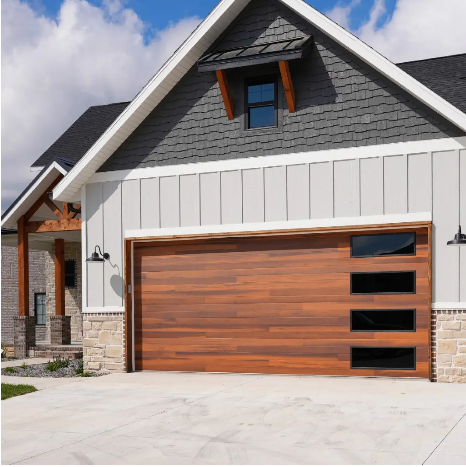Impact of Cold Weather on Automatic Garage Door Performance
How Temperature Fluctuations Affect Metal Components
When winter rolls around, garage doors face some real problems because cold makes metal shrink. The metal parts get all out of whack when they contract, which messes up things like those springs, tracks, and rollers we rely on so much. Steel tracks become really stiff in the cold according to research, so they bend or warp easier than normal. What happens next? Well, imagine trying to open your garage door only to find it stuck halfway or grinding against something. That's what often occurs when these parts aren't aligned correctly anymore after freezing temperatures take their toll.
When winter rolls around, metal fatigue starts becoming an issue for many older automatic garage doors. The cold weather actually makes metals weaker over time, and this can lead to complete breakdowns without warning. That's why checking garage doors regularly throughout the colder season is so important. Homeowners should look for signs like strange noises or difficulty opening/closing the door before things get worse. A little bit of regular upkeep goes a long way toward keeping garage doors working properly even when temps dip below freezing. Most people don't realize how much difference proper maintenance makes in extending the life span of their garage door system.
Role of Lubrication in Winter Door Operation
Keeping garage doors running smoothly through winter means proper lubrication is pretty important. When temps drop below freezing, regular grease tends to get all thick and gummy, making doors drag instead of gliding like they should. For best results in cold weather, most folks swear by silicone based lubes. These stay workable even when it's really chilly outside, so they don't turn into a sticky mess that actually makes opening and closing harder than before. The difference between good lubrication and bad can mean the difference between a door that works fine and one that needs constant adjustment throughout the season.
Keeping doors properly lubricated throughout winter makes them easier to operate and helps protect those moving parts from wearing out too fast. When we talk about regular maintenance, this means greasing up those hinges, rollers, and whatever else moves on the door. Cold weather takes a real toll on metal components over time. Taking care of these things before problems start saves money in the long run instead of dealing with broken springs or stripped gears when temperatures drop below freezing.
Choosing the Right Silicone-Based Lubricant
Getting good garage door performance through winter means picking out a quality silicone lubricant. These kinds of lubes work better when temps drop because they stay effective even in freezing weather. They also resist water much better than other options on the market, so parts don't get stuck or freeze up. Look around for brands that have been tested at low temperatures. A certification sticker usually means the product actually works in real cold conditions. This gives peace of mind knowing doors won't jam up when needed most, especially after snowstorms or icy mornings when getting into the garage becomes absolutely essential.
Step-by-Step Guide to Proper Lubrication Techniques
Keeping garage doors running smoothly during cold weather means getting the lubrication right. Start off by giving those tracks and rollers a good wipe down with a clean rag. Dirt builds up fast and gets in the way of proper lubrication. Once everything is clean, grab some silicone spray lubricant and go over all the moving bits - hinges, springs, those little roller wheels too. Don't go crazy though! Too much grease just ends up attracting more grime than it's worth. After coating everything, give the door a try and see how it moves. Sometimes doors still act stiff even after lubricating. When that happens, take another look around for anything else that might be causing problems. A second pass usually sorts things out pretty well.
For more detailed guidance on product selections, don't forget to check out certified silicone lubricants for optimal winter performance.
Addressing Track and Roller Issues in Freezing Conditions
Realigning Warped Tracks Caused by Thermal Contraction
Cold weather poses significant challenges for garage door tracks, primarily due to thermal contraction, which can cause the tracks to warp and lead to operational disturbances. Realigning these tracks is essential to ensure the door functions safely and prevents it from getting stuck. Hereâs a step-by-step approach:
- Use a Level for Alignment: To determine if the tracks are misaligned, a level can be extremely helpful. It helps in identifying the severity and specific areas of warping that require correction.
- Regular Inspections: Conducting regular inspections during the transition of seasons is advisable. Catching issues early can save on potential costly repairs and maintain the door's proper functioning.
Such regular maintenance and attention to track alignment can substantially prevent issues, improving the longevity and performance of garage doors in cold climates.
Cleaning Debris from Roller Paths for Uninterrupted Movement
Keeping roller paths clean is crucial for maintaining the smooth functionality of garage doors, especially during the winter months when snow and dirt can quickly accumulate. A proper cleaning regimen is essential:
- Thorough Inspection: Begin by inspecting the rollers and tracks. Look for any dirt, snow, or debris build-up that could potentially cause damage or hinder the door's operation.
- Employ Proper Cleaning Tools: Use appropriate tools such as soft brushes or cloths to remove debris without damaging the equipment. This prevents damage and ensures that rollers can move freely.
- Regular Maintenance: Implement a consistent cleaning schedule to reduce the risk of malfunctions. Neglecting roller path maintenance can lead to more severe issues and potential breakdowns, especially in freezing conditions.
By maintaining clean roller paths, you can prevent interruptions in movement, ensuring that the garage door operates smoothly even during the coldest months. This approach, aligned with regular track realignment, forms part of a comprehensive winter care strategy for garage doors.
Adjusting Opener Settings for Cold Weather Efficiency
Modifying Force and Limit Settings for Winter Demands
In the colder months, altering the force and limit settings of garage door openers is vital for accommodating the changes brought by cold weather.
- Winter Adjustments: Cold temperatures may affect the door mechanisms, resulting in sluggish performance or even failure. By consulting the manufacturer's user manual, you can determine optimal setting adjustments for winter efficiency.
- Enhanced Operation: The right adjustment leads to smoother door operations. It prevents excessive wear on components, reducing risks associated with opening and closing during harsh conditions.
Ensuring that these settings are tailored to winter demands will help prolong the lifespan of your garage door opener and maintain its functionality.
Resolving Sensor Alignment Issues in Low Temperatures
Low temperatures often lead to sensor misalignment, which can impede the garage door's ability to open and close correctly.
- Regular Checks: It is crucial to regularly inspect the alignment of sensors as part of your seasonal maintenance routine. Misaligned sensors can cause the door to malfunction or stop midway.
- Professional Suggestions: Experts recommend verifying the alignment and functionality of photo-eye sensors, particularly when temperatures drop. These sensors are critical for safe garage door operation.
- Efficient Performance: Promptly resolving alignment issues prevents accidents and enhances overall garage door efficiency during winter.
By incorporating these practices into your maintenance routine, you can prevent operational disruptions and ensure safe garage access regardless of temperature changes.
When to Seek Professional Automatic Garage Door Repair
Identifying Spring Failures Requiring Expert Attention
Knowing when to get a pro involved with broken garage door springs matters a lot for keeping the door working right. Most folks notice something's wrong when they hear strange noises while opening/closing the door or when the door just won't move properly anymore. Industry guidelines suggest replacing those springs somewhere around 7 to 9 years old as a general rule of thumb. But real life isn't always so straightforward - harsh winters really take a toll on them because metal actually shrinks when it gets freezing cold outside. Springs snapping back suddenly poses serious risks too; people have been hurt before by these things flying apart unexpectedly. That's why calling someone who knows what they're doing makes sense instead of trying to fix it yourself. A qualified tech will install everything correctly and adjust things properly, making sure nobody gets hurt and the door keeps functioning safely over time.
Recognizing Persistent Mechanical Issues Beyond DIY Fixes
Garage doors showing ongoing mechanical troubles often need something beyond basic DIY fixes. Regular maintenance might not tackle issues where the door gets stuck or emits grinding sounds, pointing towards deeper problems needing expert attention. Doors that struggle to move properly or parts showing signs of heavy wear are definitely red flags for calling in someone who knows what they're doing. Most homeowners simply don't have the tools or experience to handle serious mechanical failures safely. Trying to fix major issues without proper knowledge risks causing even more damage down the road. Getting help from professionals early on saves money in the long run while keeping everyone safe around the property.
Frequently Asked Questions
Why do garage doors often malfunction in cold weather?
Cold weather can cause metal components in garage doors to contract, leading to misalignment and increased metal fatigue, resulting in potential malfunctions.
What type of lubricant is recommended for garage doors during winter?
A silicone-based lubricant is recommended as it remains effective in low temperatures and prevents gumming up.
How can I prevent my garage door from jamming during winter?
Regular maintenance, such as cleaning tracks and rollers and applying the appropriate lubricant, helps prevent jamming during winter.
When should I call a professional for garage door repairs?
If you notice spring failures, persistent mechanical issues, or problems beyond DIY fixes, it is advisable to seek professional repair services.
Table of Contents
-
Impact of Cold Weather on Automatic Garage Door Performance
- How Temperature Fluctuations Affect Metal Components
- Role of Lubrication in Winter Door Operation
- Choosing the Right Silicone-Based Lubricant
- Step-by-Step Guide to Proper Lubrication Techniques
- Addressing Track and Roller Issues in Freezing Conditions
- Realigning Warped Tracks Caused by Thermal Contraction
- Cleaning Debris from Roller Paths for Uninterrupted Movement
- Adjusting Opener Settings for Cold Weather Efficiency
- Modifying Force and Limit Settings for Winter Demands
- Resolving Sensor Alignment Issues in Low Temperatures
- When to Seek Professional Automatic Garage Door Repair
- Identifying Spring Failures Requiring Expert Attention
- Recognizing Persistent Mechanical Issues Beyond DIY Fixes
- Frequently Asked Questions

